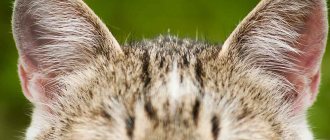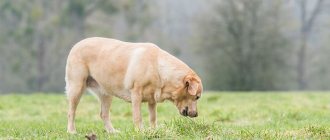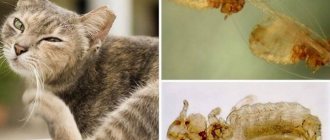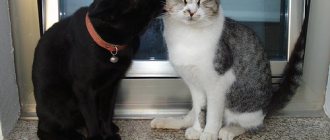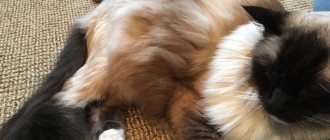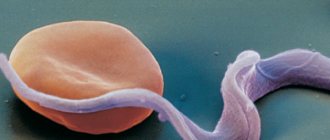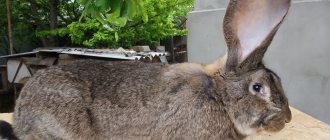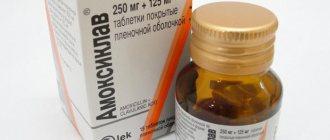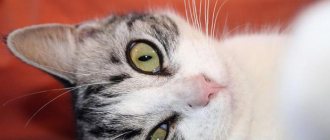Why does a cat need greens?
The presence of grass in the diet is necessary for felines. Greens perform several important functions:
- Fresh juicy grass for cats is a source of vitamins and beneficial micro- and macroelements. Vegetable food is especially rich in B vitamins, vitamins A, D, E, calcium, fluorine, magnesium, phosphorus, silicon, and folic acid.
- The fiber contained in the grass helps improve the digestion process. Natural plant fibers help normalize intestinal function.
- Hard stems, entering the stomach, provoke a gag reflex. With grass and vomit, hard-to-digest food remains (claws, bones, feathers) are removed from the body. In addition, this is how hair comes out, which enters the stomach when the cat licks itself and accumulates, forming dense clumps.
- The herb is used by animals as needed, as a laxative or fixative. It has long been noted that if a cat is constipated, he chooses plants with a wide stem. A pet suffering from diarrhea will choose narrow stems.
“Perhaps this grass will be suitable...
Another explanation is possible - cats happily gnaw on fresh stems and leaves because of the tasty, natural juice they contain.
Or maybe they just like the taste of grass.
LiveInternetLiveInternet
Any cat owner or person who cares about these animals has noticed how street cats eat grass on lawns and flower beds, and pets periodically try to eat indoor plants in pots. Some might think that this is a game for a cat, but in fact, eating greens plays an important role in the proper functioning of the animal’s body. Really, why do cats eat grass? According to their physiology, they are absolutely not vegetarians. Switch your cat to plant foods, even those rich in protein, and you will doom him to blindness.
Everything is very simple. Only from animal proteins do cats synthesize two vital amino acids that nourish the retina of the eye and provide them with vision. Nevertheless, grass is also necessary for cats - it is an additional source of vitamins and nutrients. Grass provides their diet with the need for coarse fibrous feed. The herb also helps improve digestion.
Although for some reason many people believe that cats eat grass only to clear the stomach of hairballs, causing vomiting. Indeed, predators, including cats, require fibrous food. Ready-made cat food is already enriched with fiber, but grass is much more attractive to cats. In addition, fiber is found naturally in grass.
Many of the herbs provide the cat with the necessary vitamins, macro- and microelements, which are an important element of a balanced diet:
- B vitamins (choline and biotin)
- fat-soluble vitamins E, A, D
— micro- and macroelements (silicon, phosphorus, potassium, calcium, magnesium, sulfur, manganese, selenium, iodine, zinc, bromine, copper, cobalt, chromium, fluorine)
- including folic acid.
If the owner does not take care of his animal, the cats themselves find a way out.
Your pet eats indoor plants with amazing persistence, and in winter, indoor plants are also nibbled by those cats that have the opportunity to walk outdoors in the summer, this is a sure sign that the cat needs grass.
Sometimes they gnaw not only flowers growing on the windowsill, but even nibble on bouquets of flowers or gnaw on a broom. They can also eat seedlings that have been carefully prepared for the garden.
But this can be dangerous for your pet's health, since many indoor plants are poisonous to cats, for example, mistletoe, rhododendron, and daffodils. Do not forget that outdoor plants and lawns are treated with pesticides or fertilizers, which are also hazardous to the health of cats. Exhaust gases also accumulate in the grass.
What grass does a cat like?
Of course, the favorite herbs for cats are valerian and mint. Burying their muzzle in their leaves, they experience pleasure. These herbs take them to seventh heaven. But they only like the smell of them, and nothing more. And in this article we are talking about what kind of grass a cat eats.
Cats do not eat the first plants they come across, but only cereal grasses (which form a spikelet during the period of seed maturation), grasses like sedge. The best options for them are green oats, wheat, rye and barley. During the first few days, germinating seeds strain all their strength to form a root as quickly as possible, gain a foothold in the soil and bring their first leaves to the sun. Sprouted seeds carry a lot of energy. The amount of antioxidant vitamins and microelements increases tenfold during germination.
It is during this short period (when there are droplets of juice on the tips of the leaves) that cats eat grass with great pleasure. They cut it like a lawn mower, and after 2-3 days only the roots remain from such a meadow.
How to grow grass for cats?
A good owner will make sure that the cat always has fresh grass.
I grow oats for my cat, which quickly produces lush green grass. I buy oat seeds at the market, they are inexpensive (20-30 rubles per kilogram).
Why oats? I sprouted grass for my cat many times from store-bought bags, but this greenery did not arouse any particular appetite in her. And he eats oats with pleasure and always, just have time to plant them! Moreover, oats also contain silicon.
Growing grass for cats
There are no complications or wisdom here. I have three 6 cm deep processed cheese boxes with a lid for this purpose, since germination requires a greenhouse effect.
Why three? Here everything is put on the conveyor belt. While the cat eats the first seed for a week, sprouts sprout and grow in the second box, and in the third box, under the greenhouse, that is, under the lid, the sown seeds hatch.
But you can also use decorative flower pots, but only in small quantities. The grass grows quickly, and cats love to nibble on fresh shoots. Voila, grass grew out of the hat. Such creative eco-containers will decorate your interior.
How to sow grass for cats
I pour a thin layer of earthen mixture onto the bottom of the box and water it so that the earth is saturated with moisture and swells. You can use vermiculite, or you can sow it on gauze and cotton wool. Or you can use a napkin or several layers of folded toilet paper (again, saving and sterile).
I cover the oat grains in a thick layer so that the entire area is covered. This way the shoots turn out dense, without bald spots. I again pour a thin layer of soil on top and water it, but don’t flood it. The container turns out to be half filled, since during germination the seedlings and roots lift a layer of soil and it spills out. Well, if you chose the economical method, then several layers of wet cellulose on top.
I close the lid loosely and put it in a warm place (it’s not hard to find in the kitchen). After 2-3 days the seeds hatch, I remove the lid and place it on the window to grow. All! After a week, the pussy can feast on fresh greens.
Many stores (including online) offer seeds for growing grass for cats. Once you purchase your seeds, simply follow the instructions. You can even find a complete grass growing kit for sale with seeds, pots, soil and instructions. As a rule, pre-packaged, colorful bags in the store are also inexpensive, but with this sowing method you will need a lot of them.
And in conclusion, let me remind you about the feeding habits of cats and why they still eat grass.
Although a cat is a predator, in nature, when it eats mice and birds, it eats them whole, and they may also have grains and other plant debris in their stomach. These fibers, in turn, help improve digestion and saturate the body with useful substances.
Grass is essential for cats, especially in winter. A good owner will always make sure that it is present in his pet’s diet. I would like to warn cat owners so that in the summer they are not tempted to bring grass home to their animals from the street. Outdoor grass can be infected with helminth eggs, so even in spring and summer it is much safer to sprout grass for your pets at home. cats-burg.ru
What grass do cats like?
Mint and valerian are the first names of herbs that come to mind when talking about what cats love. But these plants have nothing to do with food. Whiskered pets enjoy only the scent. It would never even occur to them to eat even one leaf from a fragrant branch.
Meanwhile, depending on their preferences and needs, cats eat a wide variety of grass. But there is still a list of plants that will appeal to almost everyone, regardless of breed and age.
Green cereals are well-deservedly loved by cats. Primarily these are oats, wheat and barley. Young sprouts are soft, juicy and contain many useful substances.
Some types of greens that people eat are also enjoyed by cats:
- parsley – will enrich the diet with a large amount of vitamins;
- rosemary - a pot of this plant, standing in the house, will rid the cat of fleas, especially if it chooses a place next to it;
- lemon balm (peppermint) – attracts with its bright aroma and acts as a sedative;
- thyme is a Mediterranean seasoning, respected by many culinary specialists, and also liked by gourmets among cats;
- lemongrass (lemon grass) – gives a slight calming effect, improves digestion, removes excess fluid from the body, helps in the treatment of many diseases, as it is a natural antibiotic and antiseptic.
“Took a bath” in mint
Some indoor plants also attract the attention of cats. These include:
- violets;
- chlorophytum;
- lavender;
- marigold.
Fluffy purrs also really like carrot tops.
Why do cats eat grass?
Despite the fact that for many owners the sight of a cat chewing grass is unusual, this is a craving inherent in nature - cats had to live in the open air without the owner's care. So the animals obtained food to the best of their strength and capabilities. Their food consisted of rodents, birds and vegetation. Herbal food helps the digestion process - the animal regurgitates excess food, so grass for cats can be called a kind of cleanser of the stomach and intestines: the blades of grass gather into a lump, which collects everything undigested from the walls of the stomach.
Instincts have not disappeared in modern cats - they still look for places with green plants with interest, and do not disdain home flowers, biting their leaves. The owners, seeing such disgrace, seek to punish the animal, although, it turns out, they are punishing it for the manifestation of instinct.
Experts have different opinions: some are convinced that the herbal delicacy does not bring any particular benefit to the animal, but simply serves as a succulent variety to the diet. Others believe that weed helps cats get rid of parasites that fiber cannot handle. Eating vegetation helps improve the digestive process and intestinal motility.
The answer to the question why cats eat grass can be answered this way: it helps to regurgitate undigested debris that has entered the stomach, and at the same time saturate the body with vitamins and minerals. The succulent vegetation contains zinc, niacin, manganese, acids, folic acid and vitamins.
How to germinate?
Growing a delicious green lawn for your pet at home is not difficult. Grass can be planted in several ways, both in soil and without it.
In vermiculite
Vermiculite is an organic, environmentally friendly mineral component. Due to its porous structure and the presence of many natural elements that have a beneficial effect on the growth and development of plants, it is actively used in gardening. Particularly good for planting seeds.
Mix the grains selected for planting with vermiculite. Pour in cool water for 1 – 1.5 hours. Drain off excess water and pour the mixture into a container with low sides. There is no need to make holes in the bottom. Fill the tray no more than half the height, since during growth the roots will swell the mixture, it will rise and may spill out of the container. And vermiculite, when saturated with moisture, greatly increases in volume.
The tray should be placed in a plastic bag and placed in a warm place. It turns out that the seeds will germinate in a kind of greenhouse. After two or three days, the first shoots appear. And in about five days, the blades of grass will be large enough for the cat to freely feast on them.
Such an improvised flowerbed can produce a harvest in about 20 days. The main thing is not to forget to water the lawn generously once every 4-5 days, and after 10 to 15 minutes drain the excess water.
Vermiculite
The big advantage of this method is that the greens grow unevenly. While the seeds at the bottom are pulling the sprouts towards the light, the top ones are already turning green with might and main. Therefore, your pet always has fresh young grass.
There are also disadvantages. Firstly, if your pet gets carried away with food, it may try vermiculite, and this will definitely not benefit the cat’s body. Secondly, a careless animal can scatter pellets throughout the room.
In the ground
The classic method - planting in the soil is also great for growing vitamin-rich treats for your pet. Once a suitable container for planting has been found (this could be a flower pot or trays left over from food products), soil and seeds have been purchased, it’s time to get down to business.
- Soak the seeds in cool water for 1-2 hours.
- Fill two thirds of the container with soil.
- Place the seeds on top and spread over the entire area in an even, thin layer.
- Sprinkle with a small amount of soil (layer height no more than 2-3 cm).
- Water. There is no need to fill the pot with water, but there should be enough of it to thoroughly moisten the soil.
- Cover with a plastic bag or film to create a greenhouse effect, so shoots will appear faster.
- Place in a warm place and observe.
- During the first few days you will need to compact the soil a couple of times. Otherwise, the cat, trying to eat the grass, will easily pull out the crops along with the roots.
- As soon as the first shoots grow a little, remove the film and place the container with grass where it is convenient for the cat to approach it.
- Everything is mine!..
Grass planted in this way will grow in 2-3 weeks. All this time, you need to take care of the flowerbed: water and remove yellowed, dried stems.
In gauze
It's just as easy to grow green treats for your cat without soil. You will need two plastic plates of different diameters, gauze and seeds.
- In a smaller plate, make 15 - 20 holes of small diameter (you can use an awl). They will serve to drain water.
- Place gauze folded in several layers on the bottom of a small plate and moisten it generously. Instead of gauze, you can put a layer of cotton wool or cotton pads.
- Place a layer of seeds on a damp cloth.
- Cover the seeds with large-mesh gauze.
- Place the smaller plate in the larger one.
- Place the entire structure in a plastic bag or cover with film on top.
- Place in a warm, well-lit place.
- Water the lawn at least once every two days.
Seeds planted on gauze germinate on the third day. And after a week, the seedlings grow so much that they can already be offered to the cat. Such grass rarely lives more than 10 days because the delicate roots are practically exposed. Experts advise rinsing the roots under running cool water once a day.
Required Components
This method is less productive and a little more labor-intensive. But it works great when there is neither soil nor a suitable pot at hand.
How to Grow Grass for Cats
There are several ways to plant grass for your cat.
The first method is to plant grass in the soil. Seeds are sold at pet stores. The soil can be purchased either as a substrate for plants, or you can prepare it yourself. The grass will grow in a container: flowerpot, pot, tray, box. There are no restrictions here.
The seeds are soaked in water for 40-60 minutes and sown in prepared, slightly moistened soil. Then the future seedlings are sprinkled with earth and covered with plastic film to create greenhouse conditions. As soon as the seedlings emerge from the ground, the film can be removed. Germination time is about 2-4 days. The next sowing will need to be done in 2 weeks.
The second method: sowing without soil. Take two plastic plates. One is smaller in diameter. We pierce the bottom of a wide plate in several places, lay out a layer of cotton wool, pour water on it and lay out grass seed for the cat. Cover everything on top with coarse gauze. Place the dishes on a small plate. The crops are covered with a bowl of larger diameter and wrapped in polyethylene until germination.
Third method: vermiculite in the cat litter box. Sowing seeds is carried out according to the first method, but only in vermiculite. Instead of vermiculite, you can take cat litter, previously soaked in water until it becomes a paste. But this option is risky because the cat may overestimate the broad gesture of the owner who decided to place her litter box on the windowsill.
Features of cultivation
When you decide to start growing grass for your pets yourself, you need to remember some important details and take into account the recommendations of experts:
- When choosing seeds, you need to pay attention to the expiration date and the name of the manufacturer. You need to purchase them only from trusted stores to avoid buying low-quality seeds or those treated with chemicals.
- As they grow, all cereals accumulate toxic substances that can negatively affect the condition of the cat. Therefore, you should not offer your pet overgrown stems. The optimal height is up to 25 - 30 centimeters.
- True, you don’t have to worry too much about this. If the grass is chosen correctly and the cat likes it, then as soon as the first shoots begin to appear, the pet will immediately begin to destroy the crops with enviable tenacity. So it is unlikely that the grass will have time to grow much; most likely it will be eaten at the beginning of growth.
- Overgrown grass becomes tough and loses most of its beneficial qualities. Strongly grown stems need to be cut off.
- You need to plant the seeds at intervals of every 8 to 10 days, then the mustachioed household will always have fresh young grass at its disposal.
- It is necessary to change the seeds to diversify the diet - one week oats, the next lemongrass and peppermint.
- You need to place a tray with grass in places where it is easy for the animal to get to and where it will be comfortable to sit while eating the greens.
Comfortable spot
Benefits and harms
When planning to grow grass for cats at home, you need to take into account both positive and negative aspects.
The benefits of fresh herbs are undeniable:
- the stomach is cleansed, the intestines work better;
- With fresh grass, beneficial substances enter the cat’s body;
- some types of herbs help in treating diseases;
- a more varied diet - in addition to protein foods, the pet receives plant foods rich in fiber.
The right herb most often cannot harm your pet, but some nuances still exist:
- an animal may have an individual intolerance to a particular type of plant;
- greens growing on the street are in most cases contaminated with parasite eggs, so feeding them to your pet is unsafe even if deworming is carried out in a timely manner;
- sometimes cats overeat fresh grass, which causes stomach upset; the owner must ensure that the animal does not consume plant food in excess;
- Many pets, deprived of the opportunity to go outside, taste not only house plants, but also bouquets in vases. This can cause irreparable damage to your pet’s health, as many seemingly harmless plants are deadly to cats.
What kind of grass do you need?
Fluffies can eat lemon balm.
Cats can be given plants such as:
- Melissa;
- cat mint;
- thyme;
- valerian;
- oats;
- wheat;
- rye;
- barley.
Valerian, mint, lemon balm, thyme, lemongrass excite your pet or, conversely, calm it down. Such herbs are more attractive to animals due to their smell. Cats prefer to eat cereals. Sprouts of fresh grass in winter are very useful. This is the best vitamin supplement for the animal’s excellent well-being. Outdoor cats eat a grass called sow thistle, known as weed. But it has medicinal properties that have a beneficial effect on the health of the pet. An animal with fur of any color, be it gray, red, black and white, outdoor or indoor, needs fresh greens.
The most favorite herb for furry pets is sprouted oats. The young cereal is rich in folic acid, carotene, potassium, magnesium, silicon, and is therefore recommended by veterinarians for inclusion in the diet of a pregnant cat and a growing kitten.

